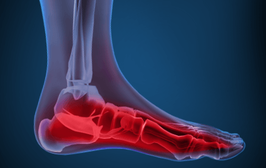 Did you know amongst other things, chiropractors frequently also treat the hips, knees and feet? Amazingly in an average lifetime, our feet carry us an equivalent of five times around the Earth and in addition to this, the feet must take the strain of supporting the body’s weight even when just standing still. Given how often we use our feet, and the demands we make upon them on a day to day basis, it’s so important to look after them properly. In each foot there is a total of 26 bones, and damage to any one of them, or even related muscles, ligaments or cartilage can result in problems with the foot that may need attention from a trained professional in order to prevent longer term damage. Here are some simple tips for you to follow to keep your feet in good condition:
Pay good attention to your feet; changes and/or pain in the feet and ankles could indicate a more serious foot ailment or circulatory problem, so if in doubt, check it out! If you think you might need support for your feet/arches then check out our biomechanics and orthotics service
1 Comment
While fun and efficient, our much-loved technological devices could be the cause of bad posture and resulting back and neck pain… Technology has become part of our everyday life. Everywhere you look people are surfing the net on their computers, writing a text message on their mobile phone or using a tablet to watch a video, which means a considerable amount of our time is being spent hunched over looking at a screen. It goes without saying that our techno devices bring a lot of fun and efficiency into our lives, but they can also, unfortunately bring a multitude of problems for our backs and necks, which is why correct posture when you are spending a lot time in front of a screen is extremely important. Central Bath Chiropractic and Physio01225 683007Our bodies are very robust to general postural stress but to reduce repetitive loads follow these simple Do's and Don’t's:
Do
Don’t
Many people cringe at the sound of knuckles, elbows and other joints cracking. For years, experts have debated whether or not this common cracking could cause joint problems. It has recently been confirmed that this ‘popping’ is due to a small bubble forming between your joints. The bubble forms when your joints move apart, forming a kind of vacuum in the synovial fluid, a slippery substance that lubricates your joints. People who can deliberately make joints like knuckles pop usually do so by pushing or pulling the joint in such a way as to make an air bubble appear with a sudden pop. This is called joint cavitation. Once the bubble is there the joint will not pop again until all the air has been reabsorbed. However, there are other cracking noises and sensations that may of concern. Snapping and cracking noises can be caused by osteoarthritis as a consequence of the natural ageing process, or following a trauma or disease in the joint. In this case the cartilage, which eases friction in the joint breaks down, so that movement causes painful friction and crunching noises. Snapping noises and sensations, on the other hand, are likely to be caused by muscle or tendon moving across a bone. This happens when a tendon is slightly loose, and occurs most often in the hip, knee, ankle, wrist and shoulder. This could eventually lead to bursitis, or inflammation of the fluid-filled sac that allows muscle to move smoothly over bone.
|
AuthorPhysioimpulse Chartered Physiotherapists Archives
June 2024
|
Services |
Get in Touch
|
©


 RSS Feed
RSS Feed

